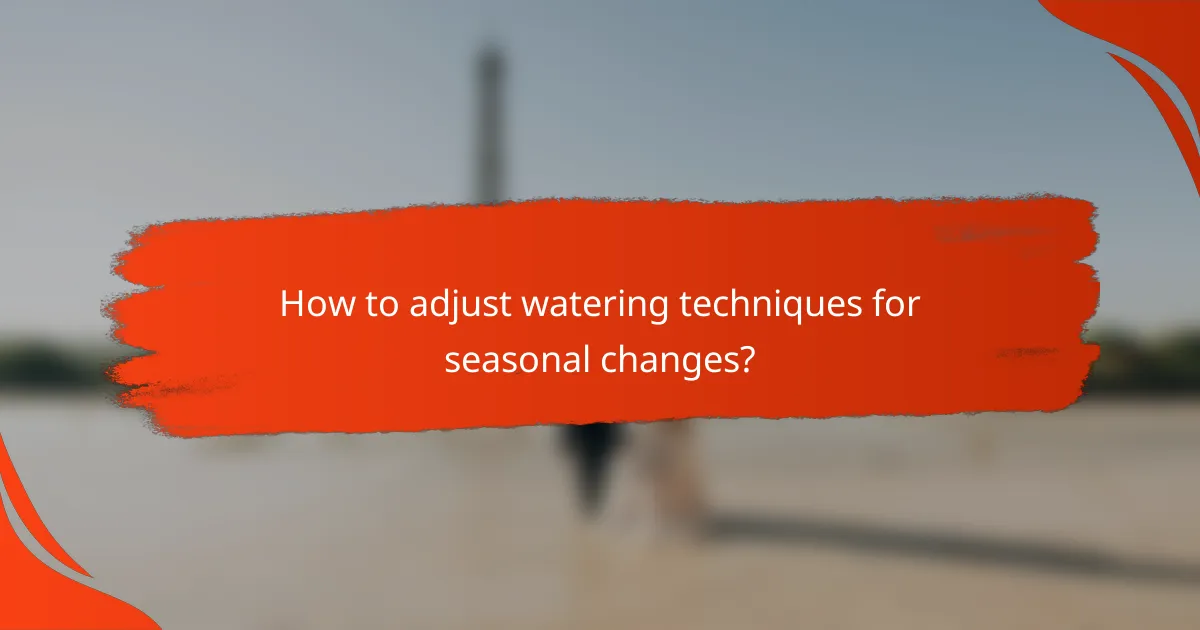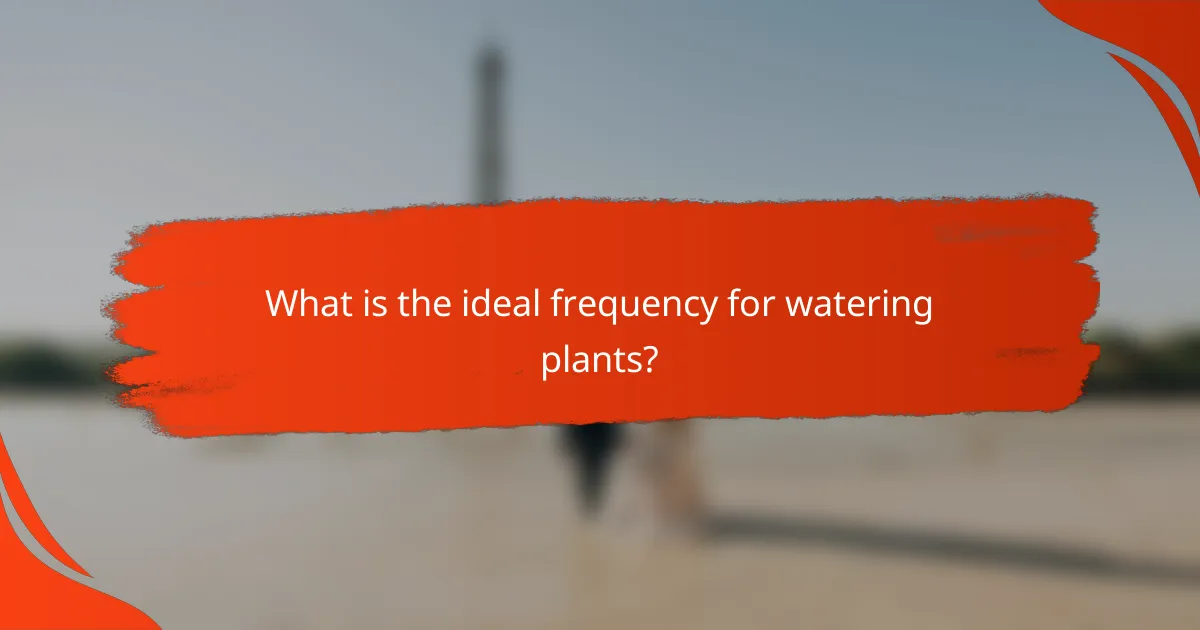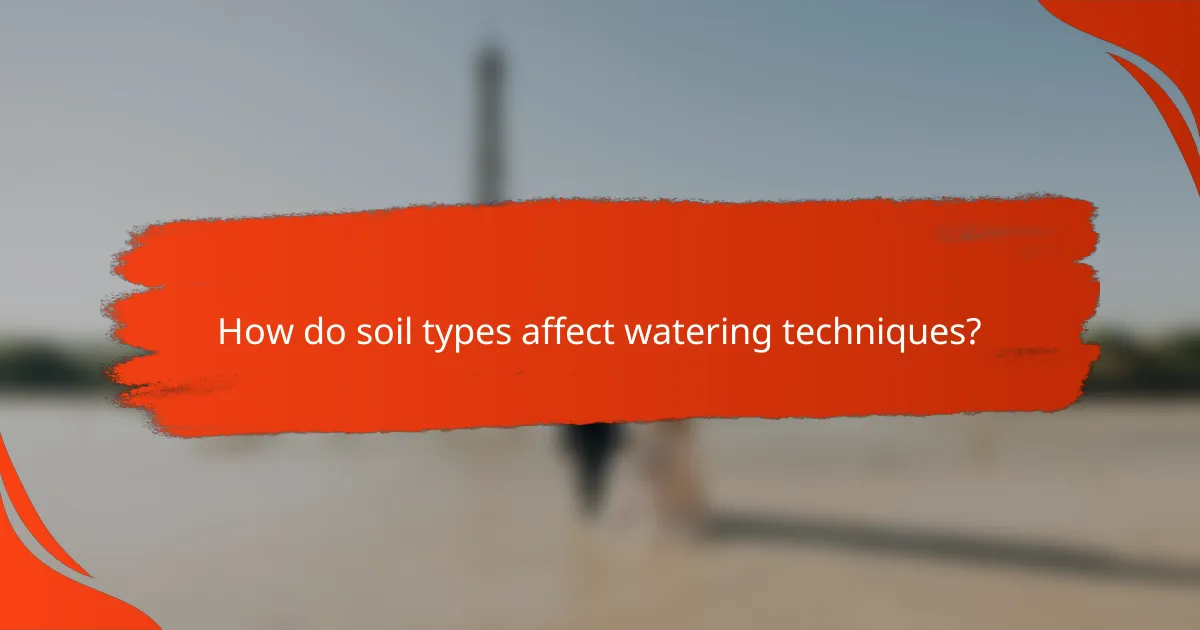Adjusting watering techniques according to seasonal changes is crucial for the health of your plants. Different seasons necessitate varying frequencies and methods to provide the right amount of moisture, preventing issues like overwatering or underwatering. Understanding the ideal watering schedule and employing effective methods can significantly enhance your garden’s vitality throughout the year.

How to adjust watering techniques for seasonal changes?
Adjusting watering techniques for seasonal changes is essential for maintaining healthy plants. Different seasons require varying frequencies and methods to ensure plants receive adequate moisture without overwatering or underwatering.
Spring watering strategies
In spring, as temperatures rise and plants begin to grow, it’s important to increase watering frequency. Aim to water deeply once or twice a week, depending on rainfall and soil moisture levels. Check the top inch of soil; if it’s dry, it’s time to water.
Consider using a soaker hose or drip irrigation to deliver water directly to the roots, minimizing evaporation. This method is particularly effective for vegetable gardens and flower beds.
Summer watering frequency
During the hot summer months, plants typically require more water due to higher evaporation rates. Watering should be done at least two to three times a week, ensuring the soil remains consistently moist but not soggy.
Early morning is the best time to water, as it allows plants to absorb moisture before the heat of the day. Avoid watering in the evening to reduce the risk of fungal diseases.
Fall watering methods
Mulching around plants can help retain moisture and regulate soil temperature, making it an effective fall watering method. Ensure mulch is applied in a way that does not touch plant stems to prevent rot.
Winter watering considerations
In winter, many plants enter dormancy and require significantly less water. However, evergreens and certain perennials still need moisture, especially during dry spells. Watering once a month may be adequate if there is no snow cover.
When watering in winter, do so on warmer days when temperatures are above freezing to prevent ice formation. Always check the soil moisture before watering to avoid overwatering dormant plants.

What is the ideal frequency for watering plants?
The ideal frequency for watering plants varies based on factors such as plant type, climate, and season. Generally, most plants benefit from being watered when the top inch of soil feels dry, which can translate to daily or weekly schedules depending on conditions.
Daily watering guidelines
Daily watering is typically necessary for plants in hot, dry climates or those in containers that drain quickly. For example, seedlings and young plants may require daily moisture to establish roots, especially during peak summer months. Monitor soil moisture closely to avoid overwatering, which can lead to root rot.
In contrast, some plants, like succulents and cacti, thrive on less frequent watering even in warm weather. Always adjust your routine based on the specific needs of each plant.
Weekly watering schedules
A weekly watering schedule is often suitable for established garden plants and outdoor flowers. Most plants do well with watering once a week, allowing the soil to dry out slightly between sessions. This encourages deeper root growth and resilience.
Consider the weather; during rainy seasons, you may need to reduce frequency. Conversely, in cooler months, some plants may require less water, so check the soil moisture before watering.
Factors affecting watering frequency
Several factors influence how often you should water your plants. Soil type plays a significant role; sandy soils drain quickly and may need more frequent watering, while clay soils retain moisture longer. Additionally, the size and type of the plant will affect its water needs.
Environmental conditions like temperature, humidity, and sunlight exposure also impact watering frequency. For instance, plants in full sun may require more water than those in shaded areas. Always observe your plants for signs of stress, such as wilting or yellowing leaves, to adjust your watering schedule accordingly.

What methods can be used for effective watering?
Effective watering methods include drip irrigation systems, soaker hoses, and manual watering techniques. Each method offers unique advantages and can be tailored to specific garden needs and seasonal conditions.
Drip irrigation systems
Drip irrigation systems deliver water directly to the plant roots through a network of tubing and emitters. This method minimizes water waste by reducing evaporation and runoff, making it ideal for dry climates or areas with water restrictions.
When setting up a drip system, consider the layout of your garden and the water requirements of different plants. Regular maintenance is essential to prevent clogging and ensure efficient operation.
Soaker hoses
Soaker hoses are porous hoses that allow water to seep out slowly along their length, providing consistent moisture to the soil. They are easy to install and can be laid out in various patterns to suit different garden shapes.
To use soaker hoses effectively, lay them on the soil surface or bury them under mulch to reduce evaporation. It’s important to monitor soil moisture levels to avoid overwatering, especially during rainy seasons.
Manual watering techniques
Manual watering techniques involve using watering cans or hoses to irrigate plants directly. This method allows for precise control over the amount of water each plant receives, making it suitable for small gardens or container plants.
When watering manually, aim for early morning or late afternoon to minimize evaporation. A good rule of thumb is to provide about 1 inch of water per week, adjusting based on rainfall and plant needs.

How do soil types affect watering techniques?
Soil types significantly influence how and when you should water your plants. Different soils retain moisture differently, which affects the frequency and method of watering needed for optimal plant health.
Clay soil watering needs
Clay soil retains moisture well but drains poorly, leading to potential waterlogging. When watering clay soil, it’s crucial to do so less frequently but in larger amounts to ensure deep penetration and avoid surface runoff.
Consider watering once a week, applying around 1 to 2 inches of water, depending on rainfall. Monitor the soil moisture; if it feels wet several inches down, delay additional watering to prevent root rot.
Sandy soil watering strategies
Sandy soil drains quickly and does not retain moisture, requiring more frequent watering. To maintain adequate moisture levels, you may need to water sandy soil every few days, especially in hot weather.
Applying around 0.5 to 1 inch of water per session can help keep plants hydrated. Use a drip irrigation system or soaker hoses to minimize evaporation and ensure water reaches the roots effectively.

What tools are available for efficient watering?
Efficient watering can be achieved using various tools designed to deliver water effectively to plants. The right tool can save time, conserve water, and ensure that plants receive the appropriate amount of moisture.
Watering cans
Watering cans are versatile tools ideal for small gardens or indoor plants. They typically come in various sizes, allowing for easy handling and precise watering. Look for features like a removable spout for adjustable flow and a comfortable handle for ease of use.
When using a watering can, aim to water at the base of the plant to minimize evaporation and ensure deep root watering. A good rule of thumb is to provide about 1-2 liters of water per plant, depending on its size and needs.
Garden hoses
Garden hoses are essential for larger areas, providing a quick way to water extensive gardens or lawns. They come in different lengths and diameters, with options for lightweight or heavy-duty materials. Consider hoses with built-in features like kink resistance and easy connectors for convenience.
To maximize efficiency, use a hose with a spray nozzle that allows you to adjust the flow and pattern. This helps target specific areas and reduces water waste. For optimal results, aim to water early in the morning or late in the evening to minimize evaporation losses.


